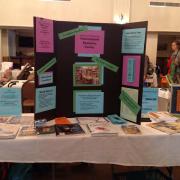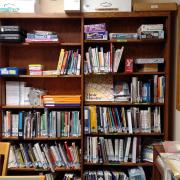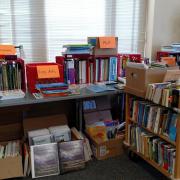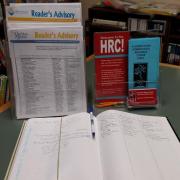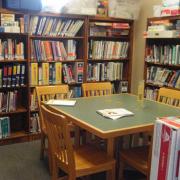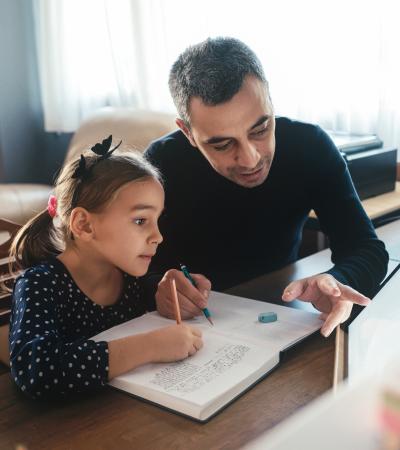What would you get if you had a dynamic volunteer with a vision and homeschool groups willing to share their wish list? You might have something like the Homeschool Resource Center operating in the Johnsburg Public Library.
Johnsburg created a comprehensive collection that meets the needs of the most discerning homeschooling parent. The collection includes titles from recognized homeschool experts, a wide assortment of full curricula, materials covering individual subject areas and a bevy of hands-on tools including science equipment, math manipulatives, educational board games, kits and software.
Advanced Planning
The Johnsburg Public Library began preparations for the HRC while writing an initial Library Services and Technology Act grant in 2001. A survey of more than 100 regional homeschoolers gave us a good idea of what they wanted, and targeted purchases were based on the survey results.
Using the $55,000 grant, we converted a quiet study room into a center that houses many materials:
- All eight major educational philosophies embraced by homeschoolers
- Curriculum and unit study materials
- Science, technology, math, historical fiction and non-fiction books
- Educational board games, puzzles and videos
- Microscopes and telescopes, as well as physics and chemistry equipment
- 3D anatomy and geology displays and 3D specimens of plants and animals
- Foreign language programs
Figuring out how to shelve and maintain such a varied collection has always been our biggest challenge. Bag kits did not work well for us, but inexpensive plastic containers in various shapes and sizes have worked better.
Marketing
The HRC has a place of prominence on the Johnsburg library’s website. Its page includes a rich mix of information, including instructions on how to limit online catalog searches to materials in the HRC, a list of local and statewide groups and resources and “Information Useful to Librarians,” which reads like a “best practices” manual for creating a resource center like Johnsburg’s.
To lead people to our webpage, we work at frequently sharing information about the HRC on social media. In addition, we attend local conferences and workshops and try to provide a presence wherever a large group of local homeschoolers may gather.
A primary long-term goal when creating the HRC was to provide a template for similar collections and services in every county in the nation. While our efforts have made a significant positive impact locally, our reach has, understandably, been more limited statewide and nationally. The HRC has been referenced in articles and books such as "Lifelong Learning in Public Libraries: Principles, Programs, and People," but we are always looking for additional ways to help other libraries create similar resources.
Budgeting
Purchasing the materials in the collection had a significant initial expense that was covered by the LSTA grant. In the 15 years since we received the grant, we have maintained the collection for a relatively small annual average thanks to generous donations and careful attention to sales and opportunities to repair equipment rather than replace. Approximately 40 percent of today's collection was part of the original material purchased in 2001.
While the library does provide a small annual budget, the center works hard to be otherwise self-sustaining. This is possible due in large part to the center's annual Homeschool Resource Center Open House and Used Curriculum Flea Market where homeschoolers can buy and sell used curriculum. The event also offers the HRC the opportunity to sell donated materials that were not added to the collection directly. The proceeds of the sale are then used to purchase new materials for the center.
Program Execution
Most families new to homeschooling spend their first two years exploring various educational options. It takes parents time to figure out what levels their children work at, what their learning styles are and which materials work best for them. As a result, I have seen new homeschooling families switch materials five, six, even seven times during this period. At the high cost of curricula, this purchase can be quite a burden when 54 percent of homeschooling families have an income of less than $50,000. Having a center where these families can “try before they buy” hundreds of options has made a significant positive impact on countless families.
The collection continues to be updated and carefully curated to maintain a balance of educational philosophies, perspectives and subjects. Changes have been necessary due to rapidly expanding curriculum options, technological advances and changing needs in the community. Shelves of VHS tapes were replaced by a handful of DVDs, and computer games that were only available on CDs have been replaced by phone apps. These technological changes have allowed for a wonderful variety of print materials, games and STEM materials.
We invite feedback at each event and via our “guest book” located in the HRC. Obviously, not everyone who visits the HRC chooses to write in the guest book but there are approximately 1,500 entries. Almost every nearby suburb is represented, and there are also frequent entries for towns up to 100 miles away as well as quite a few states.
In the guest book we invite comments and requests for specific items. Here are two examples from the guest book: "What an amazing resource center! I am excited about all the resources that are available, as I am completely new to homeschooling. This resource will be SO helpful to me in my journey of homeschooling. Laura" and "I’m so glad/thankful for this wonderful resource center! I feel a little overwhelmed — don't know what to check out first! This place is awesome! Beth."
During one usage survey, 90 percent of the HRC’s materials were checked out to out-of-district borrowers. This proves that it isn't important how many homeschoolers live in your town; it is how many will come to your town that is important! We have become a destination library — and you can become one, too.
Advice
Put simply: “If you build it, they will come.”
Approximately 3 percent of the school-age population was homeschooled in the 2011-12 school year, and the number of homeschoolers continues to grow, according to the U.S. Department of Education’s National Center for Education Statistics.
About 20 percent of respondents in a NCES survey said the reason they are homeschooling is because their child was either not being challenged enough in school or their child's special needs were not being adequately addressed.
Because homeschoolers tend to be dissatisfied with the traditional school model, they instead explore a wide variety of educational philosophies including Classical, Waldorf, Montessori, Charlotte Mason, Unit Studies and Unschooling. The most important realization for most librarians is that all of these philosophies reject mainstream textbooks in favor of “living books” — books designed to pull a reader into the topic rather than simply recite facts and figures. Historical fiction, biographies and math and science literature are all examples of living books. Of course, living books are exactly what libraries already specialize in!

